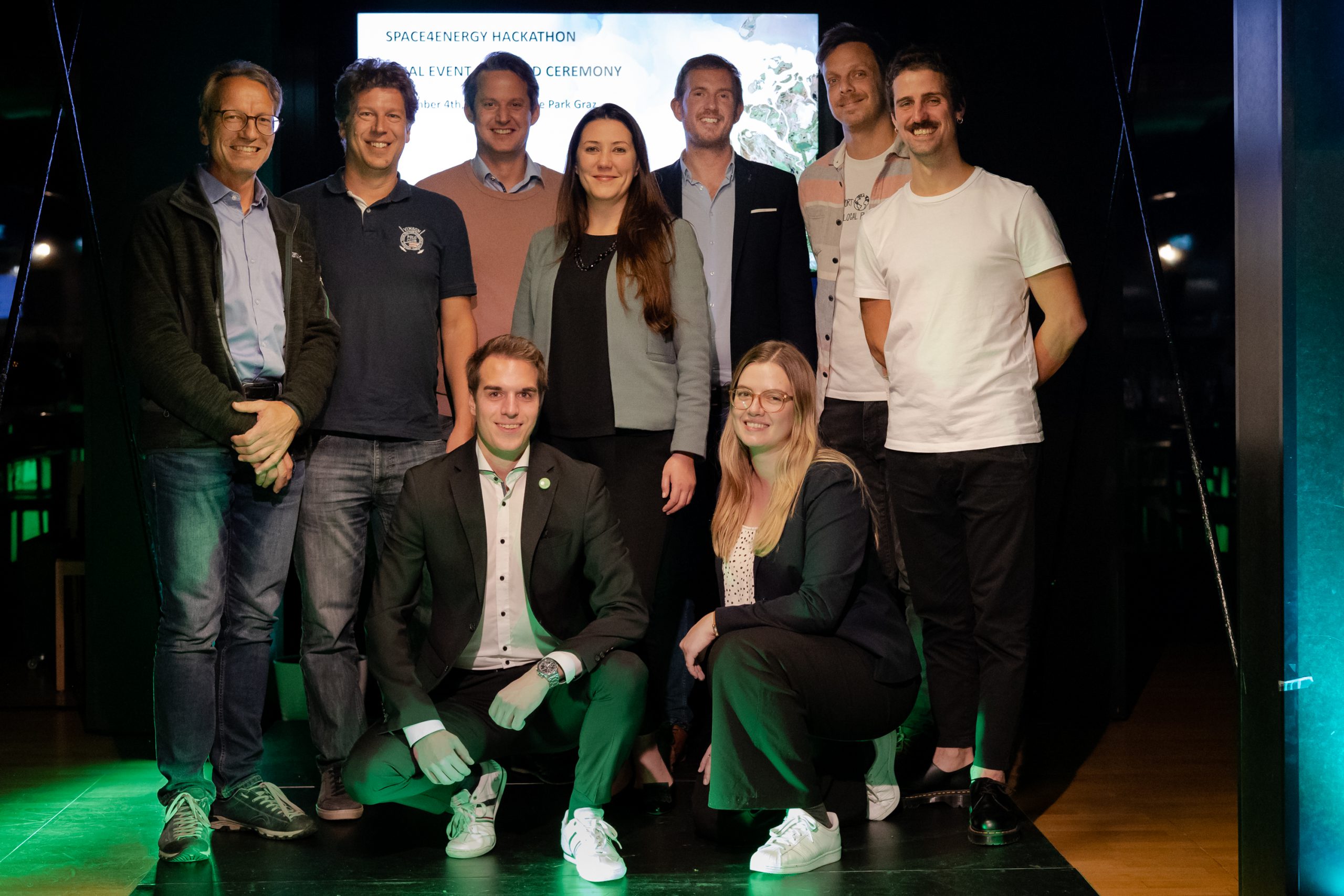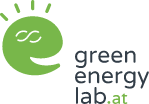“Space4Energy”: How Satellite Data Enables a Green Future
Using satellite data to design new solutions for the energy transition: This is the goal of the "Space4Energy" hackathon. The competition for start-ups and students addresses central challenges of climate and environmental protection. Federal Minister Leonore Gewessler awarded the most innovative solutions. The Austrian Federal Forests, Energie Steiermark, Kelag and representatives of the FFG project "Spatial Energy Planning for Energy Transition" were part of the showcase of innovative power implemented by the Federal Ministry for Climate Protection, ESA Start-up Center and Green Energy Lab.

f.l.: back: Karlheinz Gutjahr (Joanneum Research), Janik Deutscher (Joanneum Research), Lukas Prenner (Energie.Family), Dijana Janevska (Science Park Graz), Christian Fuchs (Austria in Space), Andreas Salentinig (ubicube), Sebastian Vogler (Beetle ForTech), front: Alexander Graf (Green Energy Lab), Sophie Hoffmann (Austria in Space) ©FotoCRafie
Space is not only a source of innovation for solutions to protect the planet, but also for new business models: the participants in the “Space4Energy” hackathon have recently demonstrated this impressively. While satellite data is already a prerequisite for applications that are indispensable in everyday life, such as navigation, air traffic management or earth observation, more than 50 participants developed a total of 17 solutions as part of the hackathon for energy industry challenges initiated by the Ministry of Climate Protection (BMK). “Space technologies and satellite data help us to better understand climate change and to make prudent, future-oriented decisions based on this understanding. Innovative applications originating in space also play a key role in developing urgently needed solutions for the energy transition and energy security on the one hand, and in establishing new, sustainable business models on the other. With our investments in national and international space programs, we are therefore supporting the development of new products and services in the climate and environment sector, which, among other things, help to drive forward the energy transition,” emphasizes Climate Minister Leonore Gewessler as part of the “Space4Energy” hackathon.
“Basis for new, sustainable business models”
The organizers, the BMK, ESA Space Solutions Austria and the Green Energy Lab, Austria’s innovation laboratory for a sustainable energy future, are delighted with the innovative power on display at the competition: “Together with our partners, we started an exciting journey with ‘Space4Energy’ at the Green Energy Lab in February of this year. It all started with an info session on the topic. A few weeks later, the first fruits of this collaboration are now showing. With the help of our large network, we succeeded at that time in identifying those application fields and casting them into concrete challenges that can bring us a big step closer to our goal of a sustainable energy system. The solutions developed now impressively demonstrate the great added value that satellite data can offer for the energy transition,” says Mathias Schaffer, Lab’s chairman, on the challenges facing the energy sector..
“Over the past few weeks, the ambitious teams have developed forward-looking solutions to the biggest challenges currently facing our society in terms of energy. The competition not only promotes innovative technologies, but also connects young, visionary academics with central leading companies from the energy industry – and is thus a turbo for new, sustainable business models based on space technology,” explains ESA Gründerzentrum Managing Director Martin Mössler.
Renowned project partners in four topics
On November 2, the participating teams presented their results or first prototypes in a digital pitching session to a top-class jury consisting of the challenge partners from the energy side, the three organizers as well as Earth observation experts from the European Space Agency (ESA), the Earth Observation Data Center (EODC) and Sentinel Hub. The ideas and development competition finally culminated in a festive closing event on November 4 in Graz. The Climate Protection Minister awarded prizes to the most sustainable and innovative solutions with the greatest implementation potential – over 8,500 euros were distributed to the winning teams.
In the four categories prevailed:
- The category „Space4Biomass“ decided the start-up “Beetle ForTech” around founder Sebastian Vogler – in cooperation with Joanneum Research – for itself.
- The young company „wematics” around founder Max Aragon sprevailed in the category „Space4Thermal“.
- Sahir Khan, Lukas Prenner and Karlheinz Gutjahr win as a freshly founded team in the category „Space4Wind“.
- „Space4SpatialPlanning“ goes to the start-up ubicube (around founder Andreas Salentinig).
The four categories were supported by renowned project partners: The Austrian Federal Forests, Energie Steiermark, Kelag as well as the team of the FFG project “Spatial Energy Planning for Energy Transition” had outlined concrete problems – with the help of satellite data, the participants developed innovative solutions.
“Space4Biomass”: satellite-assisted assessment of damage in forests
The Austrian Federal Forests dedicated their task to the satellite-based estimation of damage resulting from freak weather. While potentially poor weather conditions and the resulting inaccessibility of the terrain delay damage assessment and cleanup in affected areas, satellite data can provide rapid relief: This is because rapid and precise identification of destroyed forests not only enables rapid work organization, but subsequently also capacity planning in timber logistics. “Bundesforste is a pioneer in digitization. That is why we are constantly looking for further applications where technical solutions can support us. Windthrow, snow breakage or bark beetle infestation as effects of the climate crisis are omnipresent for us as a nature company. For this, our company is looking for new solutions for even more effective damage wood management. We are therefore pleased about the great interest in this year’s hackathon and would like to thank all participants. Every innovative solution approach that provides us with faster and more accurate information about the extent of damaging events is a valuable support for us in the forestry planning process,” says Georg Schöppl, Spokesman of the Board of Management of Austrian Federal Forests.
“Space4Wind”: Structured surfaces for wind farm simulations
Project partner Energie Steiermark together with Rheologic encouraged the participants to develop more precise simulations of historical and future wind conditions in wind farms. This is because surrounding surface structures – such as fields, meadows, industrial and residential areas – are still only inaccurately determined in order to determine wind potential and yield forecasts. This is a complex and expensive process that could be massively simplified with the help of satellite data – as part of the Challenge: An interface categorizes the surfaces – in technical jargon, this is referred to as “zonal roughness” – and makes them openly accessible. “Overall, the quality of the modeling of wind conditions in wind farms can be significantly increased. In this way, we are taking into account our overriding goal of accelerating the expansion of wind power and at the same time providing strategic impetus for innovation,” explains Thomas Wiedner, Managing Director of the Energie Steiermark innovation subsidiary Next. Rheologic-Managing Director Andras Horvath emphasizes: “The results of the participants are an important step into the future. After all, satellite data from the European earth observation program Copernicus are a valuable data basis for planning the expansion of wind power and for achieving the energy transition. Rheologic is also a pioneer in space data, as we are already using this data to improve climate resilience planning in cities.”
“Space4Spatialplanning”: Spatial energy planning for regions
How to improve spatial energy planning for regions is the focus of the FFG project “Spatial Energy Planning for Energy Transition”. Capturing the current structural development of communities and cities is a challenge. On the one hand, the data on buildings and their energy supply is incomplete in some regions; on the other hand, the possibilities for continuous monitoring of structural development are limited. There is also a need for a centralized solution to identify existing solar installations. The participants therefore looked at solutions for supplementing available data – and deriving temporal analyses from it – among other things. “Challenges such as climate change and its consequences or the growing need for secure, clean energy supplies can only be met if society and the economy change fundamentally. This requires a green and digital transformation – which can also be accelerated from a space perspective. This was impressively demonstrated by the ‘Space4Energy’ hackathon,” emphasizes Helmut Strasser, Project manager of the FFG project “Spatial Energy Planning for Energy Transition”.
“Space4Thermal”: Optimized heating or cooling efficiency
The participants of the challenge defined by the energy service provider Kelag together with HAKOM Time Series, technology leader for time series management in the energy industry, are dealing with the improvement of heating and cooling efficiency. The goal: Reduce global greenhouse gas emissions by detecting unused temperature differences in regions – such as heated residential buildings next to cooled industrial facilities. Not only the heating and Cooling efficiency can thus be improved, local decision makers:inside could also derive countermeasures for urban heat islands. “Technological innovations are needed to achieve the emissions targets. These are essential in order to become less dependent on fossil fuels and thus protect the climate. Therefore, we are happy to support such measures of the Climate Protection Ministry,” explains Kelag Board Spokesman Manfred Freitag.
In the course of the “Space4Energy” hackathon, the challenge outlined by Kelag and HAKOM was already overcome in the first steps: The map used by the company was replaced in the course of the challenge by a high-resolution, digital land surface developed in the approach, which is aimed at the use for thermal management. The smart map is designed to enable district heating network operators to detect inefficient heat transfers and heat leaks. In addition, unused urban or natural heat sources could also be identified. Technology from HAKOM Time Series is used to process the numerous different time series data efficiently and uniformly.
HAKOM Time Series Co-Founder Stefan Komornyik emphasizes: “Participating in the “Space4Energy” hackathon was an exciting experience. The innovative idea of using satellite data for a greener and more sustainable future will open new avenues for the energy industry. HAKOM Time Series will be a part of it, making the most of time series data generated in space.”
